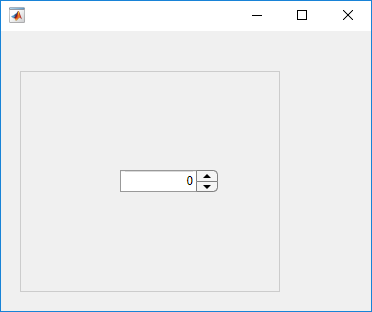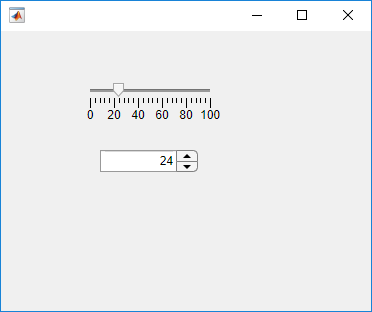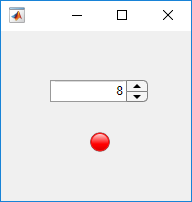uispinner
创建微调器组件
说明
spn = uispinnerSpinner 对象。MATLAB® 调用 uifigure 函数来创建该图窗。
spn = uispinner(___,Name,Value)Name,Value 对组参量指定 Spinner 属性。可将此选项与上述语法中的任何输入参量组合一起使用。
示例
fig = uifigure; spn = uispinner(fig);

在面板中创建微调器。
fig = uifigure; pnl = uipanel(fig); spn = uispinner(pnl);

创建一个微调器,限制 App 用户只能输入 0 到 100(含 0 和 100)之间的值。
创建一个微调器。
fig = uifigure; spn = uispinner(fig);
确定范围。返回的值表明上限和下限不受限制。
limits = spn.Limits
limits = -Inf Inf
将范围设置为 0 到 100。
spn.Limits = [0 100];
创建一个微调器,允许 App 用户输入大于 -5 且小于或等于 10 的值。
fig = uifigure; spn = uispinner(fig,'Limits', [-5 10],... 'LowerLimitInclusive','off',... 'UpperLimitInclusive','on',... 'Value', 5);
运行代码。如果您在微调器中输入的值超出该范围,MATLAB 将自动显示一条消息,指出存在的问题。MATLAB 然后会将值还原为上一个有效值。
创建一个微调器,允许 App 用户输入任意值,但始终只显示两位小数。请注意,MATLAB 会存储 App 用户输入的确切值。
fig = uifigure; spn = uispinner(fig,'ValueDisplayFormat', '%.2f');
运行代码,然后在微调器中输入 5.555。在微调器外点击。微调器显示 5.55。
MATLAB 存储的原始值为 5.555。
在微调器中点击,将显示最初键入的值。
创建一个微调器和一个滑块控件。当 App 用户更改微调器值时,滑块将更新以匹配该值。
请将以下代码保存到 MATLAB 路径中的 spinnerValue.m 中。以下代码将创建一个图窗窗口,其中包含一个滑块控件和一个微调器。当 App 用户更改微调器值时,ValueChangedFcn 将更新微调器,以反映滑块值。
function spinnervalue fig = uifigure('Position',[100 100 370 280]); sld = uislider(fig,... 'Position',[90 220 120 3]); spn = uispinner(fig,... 'Position',[100 140 100 22],... 'Limits',sld.Limits,... 'ValueChangedFcn',@(spn,event) updateSlider(spn,sld)); end % Create ValueChangedFcn callback function updateSlider(spn,sld) sld.Value = spn.Value; end
运行 spinnerValue。
点击并按住微调器中的向上箭头,当值达到 24 时释放鼠标按键。滑块将移动,以指示微调器值。

创建一个微调器和一个滑块控件。当 App 用户更改微调器值时,滑块将不断更新以匹配该值。
请将以下代码保存到 MATLAB 路径中的 showChangingValue.m 中。以下代码将创建一个图窗窗口,其中包含一个滑块控件和一个微调器。当 App 用户更改微调器值时,ValueChangingFcn 将不断更新滑块,以反映不断变化的微调器值。
function showChangingValue fig = uifigure('Position',[100 100 370 280]); sld = uislider(fig,... 'Position',[90 220 120 3]); spn = uispinner(fig,... 'Position',[100 140 100 22],... 'Limits',sld.Limits,... 'ValueChangingFcn',@(spn,event) spinnerChanging(event,sld)); end % Create ValueChangingFcn callback function spinnerChanging(event,sld) sld.Value = event.Value; end
运行 showChangingValue。
点击并按住微调器中的向上箭头,当值达到 24 时释放鼠标按键。滑块将随着微调器值的变化而移动。

编写 ValueChangedFcn 回调,以确定值相对于上一个微调器值是增加还是减少。将信号灯的颜色设置为值增加时显示绿色,值减少时显示红色。
请将以下代码保存到 MATLAB 路径中的 upOrDown.m 中。
function upOrDown fig = uifigure(... 'Position',[100 100 190 170]); lmp = uilamp(fig,... 'Position',[90 50 20 20],... 'Color','green'); spn = uispinner(fig,... 'Position',[50 100 100 22],... 'ValueChangedFcn',@(spn,event) spinnerValueChanged(event,lmp)); end % Create ValueChangedFcn that uses event data function spinnerValueChanged(event,lmp) newValue = event.Value; previousValue = event.PreviousValue; difference = newValue-previousValue; if difference > 0 lmp.Color = 'green'; else lmp.Color = 'red'; end end
运行 upOrDown。
当您每次更改微调器值时,ValueChangedFcn 都会确定值是增加还是减少,并相应地设置信号灯的颜色。

输入参数
父容器,指定为 Figure 对象或其子容器之一:Tab、Panel、ButtonGroup 或 GridLayout。如果不指定父容器,MATLAB 会调用 uifigure 函数创建新 Figure 对象充当父容器。
名称-值参数
以 Name1=Value1,...,NameN=ValueN 的形式指定可选参量对组,其中 Name 是参量名称,Value 是对应的值。名称-值参量必须出现在其他参量之后,但对各个参量对组的顺序没有要求。
在 R2021a 之前,使用逗号分隔每个名称和值,并用引号将 Name 引起来。
示例: 'Value',150 指定在微调器中显示数字 50。
此处所列的属性只是可用属性中的一部分。有关完整列表,请参阅 Spinner。
微调器值,指定为数值。
当 App 用户键入或更改微调器中的值时,值为字符向量。当 App 用户按下 Enter 键或者更改焦点时,MATLAB 会将 App 用户输入的值转换为双精度数字。
如果出现以下情况,MATLAB 将拒绝该值:
它无法将字符向量转换为数值标量。
值是 NaN、空白或复数。
值是数学表达式,如
1+2。值小于或大于
Limits属性指定的值。
如果 MATLAB 拒绝 App 用户输入的值,将会显示一个工具提示,说明对值的要求。微调器立即还原为以前的值,而且不会运行 ValueChangedFcn。
示例: 10
数据类型: double
值的显示格式,指定为字符向量或字符串标量。
MATLAB 使用 sprintf 以指定的格式显示值。
您可以混合使用文本和格式化操作符。例如:
spin = uispinner('ValueDisplayFormat','%.0f MS/s');
生成的微调器组件如下所示:

当 App 用户点击微调器字段时,字段将显示不带文本的值。

有关支持的格式化操作符的完整列表,请参阅 sprintf。
由 App 用户输入的小数值的舍入方法,指定为 'on' 或 'off',或者指定为数值或逻辑值 1 (true) 或 0 (false)。值 'on' 等效于 true,'off' 等效于 false。因此,您可以使用此属性的值作为逻辑值。该值存储为 matlab.lang.OnOffSwitchState 类型的 on/off 逻辑值。
'on'- 如果生成无效值,MATLAB 将对值进行舍入并执行ValueChangedFcn回调。如果生成的值超出Limits的下限或上限,MATLAB 将把值舍入到Limits之内的最接近值,然后执行回调。'off'- MATLAB 不会将小数值舍入为整数。
如果以编程方式将 RoundFractionalValues 属性值从 'off' 更改为 'on',MATLAB 将按照下列规则执行操作:
如果舍入现有值之后得到的整数位于
Limits属性指定的范围内,MATLAB 将对现有值进行向上舍入。如果舍入现有值之后得到的整数小于下限值,MATLAB 将对现有值进行向上舍入。
如果舍入现有值之后得到的整数大于上限值,MATLAB 将对现有值进行向下舍入。
如果指定的范围导致无法生成位于该范围内的有效整数,MATLAB 将把
RoundFractionalValues属性值设置回'off'并显示一条错误消息。
当 App 用户按向上和向下箭头时,Value 属性相应增加或减少的数量。
微调器的最小值和最大值,指定为二元素数值数组。第一个值必须小于或等于第二个值。将数组元素设置为 -Inf 或 Inf 分别指定无最小值或无最大值。
如果您更改 Limits,使得 Value 小于新的下限值,MATLAB 将把 Value 设置为新范围内的最小值。例如,假设 Limits 为 [0 100],Value 为 20。如果 Limits 更改为 [50 100](包含边界值),MATLAB 将把 Value 设置为 50。
同样,如果您更改 Limits,使得 Value 大于新的上限值,MATLAB 会将 Value 设置为新的上限值(假定范围包含边界值)。
示例: [-Inf 200]
示例: [-100 Inf]
示例: [-100 200]
数据类型: double
下限值的包含性,指定为 'on' 或 'off',或者指定为数值或逻辑值 1 (true) 或 0 (false)。值 'on' 等效于 true,'off' 等效于 false。因此,您可以使用此属性的值作为逻辑值。该值存储为 matlab.lang.OnOffSwitchState 类型的 on/off 逻辑值。
'on'- 值必须等于或大于下限值。'off'- 值必须大于下限值。
上限值的包含性,指定为 'on' 或 'off',或者指定为数值或逻辑值 1 (true) 或 0 (false)。值 'on' 等效于 true,'off' 等效于 false。因此,您可以使用此属性的值作为逻辑值。该值存储为 matlab.lang.OnOffSwitchState 类型的 on/off 逻辑值。
'on'- 值必须等于或小于上限值。'off'- 值必须小于上限值。
例如,如果您希望数值输入介于 0 和 1 之间,不含 0 和 1,请执行以下所有操作:
将
Limits属性值设置为[0 1]。将
UpperLimitInclusive属性设置为'off'。将
LowerLimitInclusive属性设置为'off'。
更改值后执行的回调,指定为下列值之一:
函数句柄。
第一个元素是函数句柄的元胞数组。元胞数组中的后续元素是传递到回调函数的参量。
包含有效 MATLAB 表达式的字符向量(不推荐)。MATLAB 在基础工作区计算此表达式。
当用户更改焦点,或者在更改微调器值之后按 Enter 键时,将会执行此回调。不管用户是通过键入值还是通过按箭头键来更改微调器值,都会执行此回调。如果以编程方式更改微调器值,将不会执行此回调。
此回调函数可以访问有关用户与微调器的交互的特定信息。MATLAB 将 ValueChangedData 对象中的此信息作为第二个参量传递给回调函数。在 App 设计工具中,该参量名为 event。您可以使用圆点表示法查询对象属性。例如,event.PreviousValue 返回微调器的上一个值。ValueChangedData 对象不可用于指定为字符向量的回调函数。
下表列出了 ValueChangedData 对象的属性。
| 属性 | 值 |
|---|---|
Value | 微调器在 App 用户最近一次与它交互之后的值 |
PreviousValue | 微调器在 App 用户最近一次与它交互之前的值 |
Source | 执行回调的组件 |
EventName | 'ValueChanged' |
有关编写回调的详细信息,请参阅App 设计工具中的回调。
更改值后执行的回调,指定为下列值之一:
函数句柄。
第一个元素是函数句柄的元胞数组。元胞数组中的后续元素是传递到回调函数的参量。
包含有效 MATLAB 表达式的字符向量(不推荐)。MATLAB 在基础工作区计算此表达式。
当用户点击并按住微调器上的向上或向下箭头时,将会执行此回调函数。如果以编程方式更改 Value 属性,将不会执行此回调函数。
此回调函数可以访问有关用户与微调器的交互的特定信息。MATLAB 将 ValueChangingData 对象中的此信息作为第二个参量传递给回调函数。在 App 设计工具中,该参量名为 event。您可以使用圆点表示法查询对象属性。例如,event.Value 返回微调器的当前值。ValueChangingData 对象不可用于指定为字符向量的回调函数。
下表列出了 ValueChangingData 对象的属性。
| 属性 | 值 |
|---|---|
Value | 微调器在 App 用户与它交互时的当前值 |
Source | 执行回调的组件 |
EventName | 'ValueChanging' |
在 App 用户释放箭头键之前,Spinner 的 Value 属性不会更新。因此,要获取按下箭头键时的值,您的代码必须获取 ValueChangingData 对象的 Value 属性。
注意
请避免从其自己的 ValueChangingFcn 回调中更新 Spinner 对象的 Value 属性,因为这可能导致意外行为。要更新微调器值以响应用户输入,请改用 ValueChangedFcn 回调。
回调按照如下方式执行:
如果 App 用户点击微调器中的向上或向下箭头,回调将执行一次。例如,假设微调器值为 2,
Step值为 1。如果 App 用户点击向上箭头,回调将执行一次。如果 App 用户按住微调器中的向上或向下箭头,回调将重复执行。例如,如果 App 用户点击并按住向上箭头,回调将执行多次,直到 App 用户释放向上箭头为止。
有关编写回调的详细信息,请参阅App 设计工具中的回调。
微调器相对于父容器的位置和大小,指定为向量 [left bottom width height]。此表介绍该向量中的每个元素。
| 元素 | 描述 |
|---|---|
left | 父容器的内部左边缘与微调器的外部左边缘之间的距离 |
bottom | 父容器的内部下边缘与微调器的外部下边缘之间的距离 |
width | 微调器的左右外部边缘之间的距离 |
height | 微调器的上下外部边缘之间的距离 |
所有测量值都以像素为单位。
Position 值相对于父容器的可绘制区域。可绘制区域是指容器边框内的区域,不包括装饰元素(如菜单栏或标题)所占的区域。
示例: [100 100 100 22]
版本历史记录
在 R2016a 中推出
MATLAB Command
You clicked a link that corresponds to this MATLAB command:
Run the command by entering it in the MATLAB Command Window. Web browsers do not support MATLAB commands.
选择网站
选择网站以获取翻译的可用内容,以及查看当地活动和优惠。根据您的位置,我们建议您选择:。
您也可以从以下列表中选择网站:
如何获得最佳网站性能
选择中国网站(中文或英文)以获得最佳网站性能。其他 MathWorks 国家/地区网站并未针对您所在位置的访问进行优化。
美洲
- América Latina (Español)
- Canada (English)
- United States (English)
欧洲
- Belgium (English)
- Denmark (English)
- Deutschland (Deutsch)
- España (Español)
- Finland (English)
- France (Français)
- Ireland (English)
- Italia (Italiano)
- Luxembourg (English)
- Netherlands (English)
- Norway (English)
- Österreich (Deutsch)
- Portugal (English)
- Sweden (English)
- Switzerland
- United Kingdom (English)